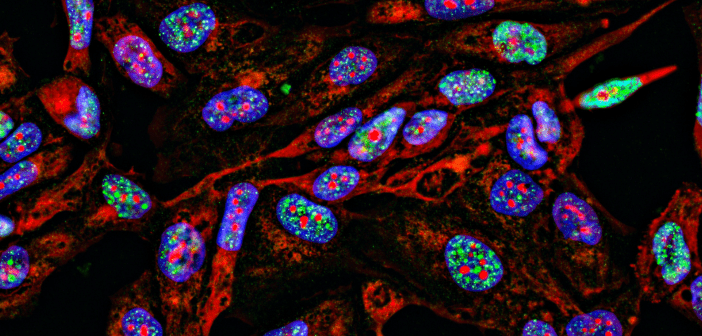Light it up: imaging agents light up cancer biomarkers for clearer view of tumors during surgery

Researchers from the University of Illinois Urbana-Champaign (IL, USA) have found new imaging agents that can illuminate multiple biomarkers a once, which could mean surgeons may have a clearer view of tumors during surgery.
The team used fluorescent nanoparticles, which are wrapped in red blood cell membranes, to target the tumor. The nanoparticles worked better than current, clinically approved dyes and can emit two distinct signals in response to one beam of surgical light, a feature that could help doctors identify metastatic cancers and distinguish tumor borders. Bioinspired cameras can be combined with imaging agents, which, previously, the researchers had developed for real-time diagnosis during surgery. In this study, published in ACS Nano, the researchers demonstrated their dual-signal nanoparticles in tumor phantoms and in live mice.
“If you want to find all the cancer, imaging one biomarker is not enough. It could miss some tumors. If you introduce a second or a third biomarker, the likelihood of removing all cancer cells increases, and the likelihood of a better outcome for the patients increases.” explained Gruev, who is also a professor at the Carle Illinois College of Medicine (IL, USA). “Multiple-targeted drugs and imaging agents are a recent trend, and our group is driving the trend hard because we have the camera technology that can image multiple signals at once.”
Conventionally, a surgeon will remove a tumor and send it to a pathologist for assessment, which can be a lengthy process and, as research has moved into real-time diagnostics, there have been several challenges preventing wider application. Many tumor-targeted imaging agents only minimally reach their tumor targets and instead are quickly cleared from the blood and eventually accumulating in the liver.
“A few people before us have used nanoparticles coated with red blood cells and found they circulate longer – a few days. We saw the same thing in our mice: The membrane-coated nanoparticles circulated longer in blood, with reduced uptake in the liver. Because they were circulating longer, more of the imaging agents accumulated in the tumors, giving us a stronger fluorescent signal,” reported Illinois postdoctoral researcher and first author of the paper, Indrajit Srivastava.
Of the two biomarkers targeted by the imaging agents, one is prevalent in early-stage cancer and the other in late-stage cancer. The research team discovered that the nanoparticles were effective at distinguishing healthy tissue from cancerous tissue, as well as being able to differentiate the two signals from one another.
“This is appealing for surgical application, as it could help determine where exactly to make the cut. Having multiple signals gives a more overall picture of the tumor. And it could tell a surgeon, ‘This may be metastatic, you may want to be more aggressive in your removal.’” Srivastava stated.
Another benefit for surgical applications is the need for only one wavelength of laser light to elicit multiple signals, as this allows the instrumentation to be more compact than those requiring multiple lasers for each needed wavelength. The study team is planning to move forward with additional preclinical and clinical studies using their dual-signal dyes with surgical goggles and is looking to develop more tumor-imaging agents that target multiple markers.
“In this battle for ensuring we remove all the cancer cells during surgery, we need investments both in the imaging camera technology and in the tumor targeting agents,” Gruev commented. “This work is helping us better realize and guide the holistic approach that we are taking as we are getting closer and closer to clinical trials.”
Sources: Srivastava I, Lew B, Wang Y, et al. Cell-membrane coated nanoparticles for tumor delineation and qualitative estimation of cancer biomarkers at single wavelength excitation in murine and phantom models. ACS Nano. 17(9), (2023) doi: 10.1021/acsnano.3c00578. Illinois News Bureau press release, www.news.illinois.edu/view/6367/1977747998



